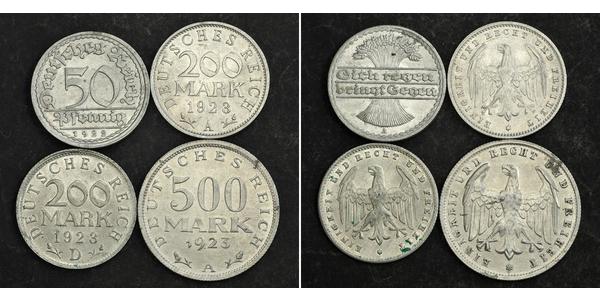(Vendue pour $1.0)
1922/1923, Germany (Weimar). Aluminum 50 Pfennig + 200 & 500 Mark Coins. 4pcs!
Mint Year: 1922 / 1923 Condition: Minor deposits, otherwise lustre AU-UNC! Denominations: 50 Pfennig / 200 Mark (2pcs) / 500 Mark Diameter: 23mm-27mm (each) Weight: 1gm-1.66gm (each) Material: Aluminum
Weimar Republic is an unofficial designation for the German state between 1919 and 1933. The name derives from the city of Weimar, where its constitutional assembly first took place. The official name of the state was the German Reich (Deutsches Reich), continuing the name from the pre-1918 German Empire.
The republic was a semi-presidential representative democracy, and emerged in the aftermath of the German Revolution of 1918–19. A national assembly was convened in Weimar, where a new constitution for the German Reich was written, and adopted on 11 August 1919. In its fourteen years, the Weimar Republic faced numerous problems, including hyperinflation, political extremists (with paramilitaries – both left and right wing) and contentious relationships with the victors of the First World War. The people of Germany blamed the Weimar Republic, not their wartime leaders, for the country's defeat and humiliation caused by the Treaty of Versailles. The Weimar Republic successfully reformed the currency, and unified tax policies and the railway system. Germany eliminated most of the requirements of the Treaty of Versailles and never completely met its disarmament requirements, and eventually only paid a small portion of the war reparations by twice restructuring its debt through the Dawes Plan and the Young Plan. Under the Locarno Treaties, Germany accepted the western borders of the republic, but the Eastern border remained debatable for the Weimar German governments.
From 1930 onwards President Hindenburg used emergency powers to back Chancellors Heinrich Brüning, Franz von Papen and General Kurt von Schleicher. The Great Depression, worsened by Brüning's policy of deflation, led to a surge in unemployment. In 1933 Adolf Hitler became the new Chancellor of a coalition government, and Nazis held two out of the remaining ten cabinet seats. Von Papen as Vice Chancellor was intended to be the "éminence grise" who would keep Hitler under control, using his close personal connection to Hindenburg. Within months, however, the Reichstag Fire Decree and the Enabling Act of 1933 had brought about a state of emergency and wiped out constitutional civil liberties. Hitler's seizure of power (Machtergreifung) allowed him to govern by decree without the involvement of the legislature. These events brought the Weimar Republic to an end, as democracy collapsed and a single-party state was created. The end of the Weimar Republic marked the beginning of Nazi Germany.
Even so, German Foreign Office official Harry Graf Kessler had predicted as early as February 1919 that the Republic was doomed. "The paradox", he wrote, "by which a Social Democratic Government allows itself and the capitalist cash-boxes to be defended by royalist officers and unemployed on the dole is altogether too crazy."
2 Krone Suède Argent Gustave II Adolphe de Suède( – 1632)
Le groupe a 30 pièces / 28 prix
⇑















